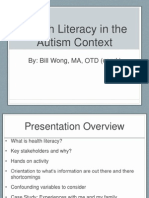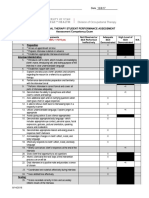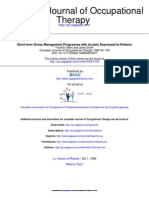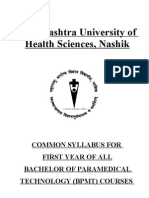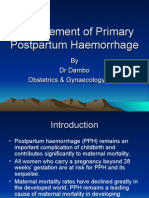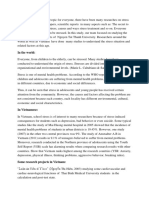Immuno Part Cs
Immuno Part Cs
Uploaded by
Cecilia TesoreroCopyright:
Available Formats
Immuno Part Cs
Immuno Part Cs
Uploaded by
Cecilia TesoreroCopyright
Available Formats
Share this document
Did you find this document useful?
Is this content inappropriate?
Copyright:
Available Formats
Immuno Part Cs
Immuno Part Cs
Uploaded by
Cecilia TesoreroCopyright:
Available Formats
Robert Havighursts Developmental Theory (Middle Age)
Growth and development are both referred to as dynamic processes. They are independent yet interrelated terms that possess factors that enable a person to achieve a state wherein he is capable and equipped to cope and deal with the existing circumstances surrounding him. It is influenced by genetic and environmental aspects. The former is established by the individual even at conception, which remains unchanged throughout life and determines most of his dominant physical attributes. Whereas the latter involves the family, religion, climate, school, community and nutritional provisions, which seem to be auxiliary details however truly poses a great impact upon the progress and maturity upon each individual. A developmental task is a task which arises at or about a certain period in the life of the individual, successful achievement of which leads to his happiness and to success with later tasks, while failure leads to unhappiness in the individual, disapproval by the society, and difficulty with later tasks. Developmenta l Tasks 1.Assisiting Teenage Children to become responsible and happy adults
The primary charge of any parent is to raise their children to become independent, responsible adults. Human experiences are continuous. They are what ultimately define everyone, including teens who build on the lessons their parents teach them over the years. Parents should help their teen flush out and discuss
Description
Achieved or Not Achieved
Justification
Our client is a mother of two, and she says that she never forgets to guide her children especially about lifes challenges and things they must do in order to become successful in life, assist them on how to socialize and involve in their community.
2. Achieving Adult Social and Civic responsibility
citizens should work towards the betterment of their community through economic participation, public , volunteer work, and other such efforts to improve life for all citizens involved in preparing for work in which one will gain personal satisfaction and find enrichment in one's life through work. Occupational development is related to one's attitude about one's work.' Traveling a path toward your occupational wellness, you'll contribute your unique gifts, skills and talents to work that is personally meaningful and rewarding. a period of time spent out of work and essential domestic activity. It is also the period of recreational and discretionary time before or after compulsory activities such as eating and sleeping, going to work or running a business, attending school and doing homework, household chores, and day-to-day stress.
Our client is member in GKK in their community.By doing this, she participates in the spiritual development of their community
3. Reaching and maintaining satisfactory performance in ones occupational career
Our client is a packer in banana plantation.she states that she loves her work but because of her condition her husband want him to stop.
4. Developing adult leisure time activities
Since the client stayed only at home, she says that she do activities such as cleaning their house, do cooking foods and sometimes watching television together with her family.
7. Adjusting to aging parents 5. Relating Oneself to ones spouse as a person
Becoming a caregiver to parents involves major changes for all It is evident that the best concerned spouse relationships physically, survive on love and emotionally, socially respect. and financially. Learning to cope with the changes in a healthy way is important to ensure While the adult years are you and your aging generally a time of vitality parents can live in a and good health, their are mutually loving and health concerns. The giving relationship. main health problems of middle adulthood are cardiovascular disease, cancer, and menopause. Another major problem that effects health and behavior is stress. Overall this is a time of major change and development physically and mentally.
Our client states that when her parents got old she did not live with them. But even with the distance, Our client states that she and her she really tries to visit her parents partner have conflicts at times, but and to check if they are well, and she she says that it is just natural for also gives support for their needs. couples to have quarrels. She states She says that we should never forget that without this quarrels you will to go back to the people who made never know the real attitude of your us who we are right now especially partner. she also states that she our parents. really cares for her husnband. Our client states that he accepts that as we grow old, we also feel some illnesses and weakness in the body. she says that this is just natural because we are just humans and all of us get sick in different ways like her. She says that to stay healthy he really eats vegetables and fruits.
6. To accept and adjust to the physiological changes of middle age
Legend: Achieved Not Achieved Not Applicable -
Eric Eriksons Psychosocial Development:
Generativity vs Stagnation (40 65 years old)
Generativity is the concern of establishing and guiding the next generation. Socially-valued work and disciplines are expressions of generativity. Simply having or wanting children does not in and of itself achieve generativity. During middle age the primary developmental task is one of contributing to society and helping to guide future generations. When a person makes a contribution during this period, perhaps by raising a family or working toward the betterment of society, a sense of generativity- a sense of productivity and accomplishment- results. In contrast, a person who is self-centered and unable or unwilling to help society move forward develops a feeling of stagnation- a dissatisfaction with the relative lack of productivity.
As for the client, she is categorized under the 7th stage, which is the Middle Adulthood Stage that is confronted with the crisis of generativity vs stagnation. Achieved Our client states that she is contended with what she has right now. She says that his family is a very big gift of God to her because this is what makes her go forward in life and continue. She also states that even if there are conflicts in her family at times she knows that this will all be solved and that this is a way wherein the y will know each other better. She states that she is really glad that he was successful in guiding his children in their studies and their behavior towards them as parents. She is also glad that she is able to function well in their community especially in the spiritual activities that they have. He also states that as we grow old, we also have limitations especially in our health. And he is also glad that even if she is far from her parents, she never forgets to look back and support them in their needs as aging parents. If we take a closer look at all the essential data weve gathered and correlate it with Robert Havighurst s developmental theory and Erik Eriksons developmental tasks, the group concludes that the client is doing well as she continues to perform his tasks laid out for an individual belonging to the same age group. We cannot say that she is already fulfilled with his development since he is still in the process of accomplishing it. However, as we can see, she is very much comfortable and at ease with the present set-up. With this, we hope that he may eventually accomplish all his task with a feeling of contentment and happiness.
A. GENERAL SURVEY The patient was lying on bed, conscious and coherent and on respiratory distress. The patient is mesomorphic. She was wearing a clean hospital gown. She has O2 inhalation @ 1liter per minute via nasal cannula and has an intravenous fluid of D5W500 regulated at KVO rate infusing well at left metacarpal vein at 300 cc level. She doesnt have any foul-odor smelling. appropriately to our questions. . B. VITAL SIGNS VITAL SIGNS Blood Pressure Temperature Cardiac Rate Pulse Rate Respiratory Rate I. SKIN, HAIR, NAILS RESULT 100/90 35.8 96 90 26 NORMAL VALUES 90/70- 130/90 35.6 37.5C 70 80 bpm 70 80 bpm 16 20 cpm She was cooperative, alert and responses
Upon inspection, skin was tan in complexion and not uniform in color. Upon palpation, skin was oily on lower extremities. Skin was rough and warm to touch. The bodys temperature is uniform all throughout the body and is within the normal range. Skin turgor was good. No edema and ulceration noted. Hair is black in color. Infections or infestations were not noted upon inspection. Body hair is variable in amount. Upon inspection, nails are clean and well trimmed. Nail beds are slightly pinkish in color. After performing the blanch test of capillary refill, there is return of usual color in 3 seconds.
II.
HEENT A. HEAD Upon inspection, head is normocephalic. Hair was black in color. Facial features
are symmetrical, palpebral fissures equal in size and symmetrical nasolabial folds are present. Facial movements are symmetrical as patient elevates and lowers the eyebrows, close the eyes tightly, puff the cheeks and smile. Upon palpation, nodules, masses were not noted. B. EYES Upon inspection, eyebrows are black, evenly distributed and symmetrically aligned.. Eyelashes are equally distributed and slightly curled outward. There is icteric sclera in both eyes. The bulbar conjunctiva is transparent. The palpebral conjunctiva is smooth and pale. Lesions are absent.
No edema or tenderness noted upon palpation on the lacrimal gland. No edema or tearing on the lacrimal sac and nasolacrimal duct. No lesions were noted. The pupils are black in color, equal in size of about 2mm in diameter. The iris appears brown in color. The pupils constricts when looking at near objects, dilate when objects are far and converge when near object is moved towards the nose. When looking straight ahead, the patient can see objects in periphery. Upon performing the extraocular muscle test, both eyes are coordinated and move with parallel alignment (six ocular movements). She was also able to read newsprint with the use of her eyeglasses.
C. EARS Upon inspection,the ears have the same color as that of facial skin, symmetrical and aligned with the outer canthus of the eye. It is mobile and not tender. After the pinna is folded, it recoils. No presence of cerumen noted. Skin lesions, pus or blood were not noted. Normal voice tones are audible and able to hear ticking in both ears during the watch tick test. D. NOSE Upon inspection, external nose is uniform in color and no discharge noted. Tenderness, masses, displacement of bone and cartilage and lesions are absent. Both nasal cavities are patent. The nasal septum is intact and in midline. The maxillary and frontal sinuses are not tender upon palpation.
E. MOUTH The lips are brown in color.Texture is smooth, and patient is able to purse lips. The oral mucosa has a uniform pink color and moist. The gums are also pink. Upon inspection, teeth are incomplete, there is cavities noted.The tongue is positioned centrally, pink in color, moves freely, and lesions, tenderness, or palpable nodules were not noted. Tongue base is smooth with prominent veins. The frenulum is in midline. The hard palate is lighter pink The uvula is positioned in midline. The tonsils are pink and not inflammed. Discharges are not noted. Gag reflex is present.
III.
NECK Upon inspection, the neck muscles are equal in size. She was capable of turning
her neck from right and left lateral without any discomfort. Jugular vien is distended at left side. Upon palpation, lymph nodes are not palpable.. No bruit heard upon auscultation.
IV.
CHEST AND LUNGS The anteroposterior diameter of the chest has a ratio of 1:2. The skin is intact,
warm to touch, and no masses noted. Chest wall expansion is symmetrical with crackles heard upon auscultation on both lungs..
V.
BREAST & AXILLAE The skin on breasts is uniform in color, smooth and intact. Areolas are oval and
bilaterally the same color and is dark brown. Nipples are round, equal in size, soft and smooth. Discharges are absent. No tenderness, masses or nodules noted on axillary area.
VI.
HEART
Upon inspection, no bulges were noted. Whooshing cardiac sounds heard upon auscultation. VII. ABDOMEN The skin color is uniform. Abdominal movements caused by respirations are symmetrical. Audible bowel sounds of 16soundsper minute are heard and absence of arterial bruit and friction rub upon auscultation. No areas of tenderness noted upon palpation. She has abdominal girth of 93 cm.
VIII.
EXTREMITIES No nodules or deformities observed on shoulders, arms and elbows. Forearms
can be flexed, extended, or put to supine and prone position. Contractures, redness, bone enlargements, nodules, atrophy and tremors were not observed. No pain or tenderness, deformities on hip joints and thigh. No lesions or deformities noted. Lesions, edema, inflammation and deformities are absent.
IX.
GENITALS AND RECTUM The patient refused to be assessed in her genital area.
X. NEUROLOGIC SYSTEM Mental Status
o Language
There was no notable defect or loss of power to express his self by speech. she was able to answer the questions asked to her. Her answers are relevant and comprehensible. o Orientation The client was able to recognize other persons such as her relatives, nurses on duty and her physician. She is oriented of the time of the day and was aware of where she is at the present moment. o Memory The patient was able to recall the foods he had taken for the whole day. He also remembered some of the hospital personnel that were assigned to him.
Level of Consciousness Glasgow Coma Scale (GCS) Eye Opening 4 - Spontaneous 5 6 - Oriented - Obeys commands
Best Verbal Response Best Motor Response
Eye opening was spontaneous; reactive to any stimuli. Pupil size were
both 2mm brisk in movement and reactive to light accommodation. Verbal response was oriented; she was able to know the person, place and time appropriately. Moreover, motor response was assessed through asking the patient to move both upper and lower extremities. She was able to follow commands without difficulty.
Reactive Level Scale Patient was alert and was able to respond spontaneously. A score of 1/15 was given to the neurological assessment of the patient.
Cranial Nerves Cranial Name Nerve I II Olfactory Optic Functions Smell Findings Identified the source of odor as
patient closes her eyes. Purely sensory; carries Patient can see objects in a impulses for vision distance and can read
III
Oculomotor
newsprints. Extraocular Movement The patient can see objects in and sphincter of pupil; periphery. When the pupil is ciliary muscles of lens illuminated, it constricts (direct movements response) and the nonilluminated pupil also constricts (consensual response)
IV
Trochlear
Moves eyeball
Patient can see objects in
downward and laterally periphery and can gaze V Trigeminal laterally. Sensation of cornea, Patient was able to elicit blink skin of face and nasal reflex. The patient was able to mucosa; sensation of open her mouth at the widest anterior oral cavity; VI Abducens and can move tongue from
muscles of mastication side to side Supplies motor fibers Patient can see objects in to the lateral rectus periphery and can gaze muscle, which rolls the laterally.
VII
Facial
eye laterally Activates the muscles Facial movements are of facial expression symmetrical as patient and the lacrimal and elevates and lowers the salivary glands; carries eyebrows, close the eyes sensory from the taste tightly, puff the cheeks and
VIII
buds of anterior tongue smile. Vestibulocochlear Purely sensory; Normal voice tones are audible vestibular branch and able to hear ticking in both
transmits impulses for ears during the watch tick test the sense of balance and cochlear branch transmits impulses for the sense of hearing
IX
Glossopharyngeal Supplies motor fiber to Gag reflex is present. Our the pharynx that client can move her tongue in
promote swallowing and out, up and down, side to and saliva production; side a little slowly. she could carries sensory impulses from taste buds of the posterior tongue and from pressure receptors of X Vagus the carotid artery Sensation of pharynx Gag reflex is present. The determine different tastes.
and larynx; swallowing; uvula is positioned in midline of vocal cord movement soft palate. Clients speech was not hoarse and there is no difficulty to talk. XI Accessory Most motor fibers that activate She can shrug both of his shoulders with ease; if applied
sternocleidomastoid with resistance from hands, still and trapezius muscles; he can move her shoulders. head movement and She can turn his head slowly shrugging of shoulders on both sides; when asked to turn to side against resistance, still she can move her head.
XII
Hypoglossal
Motor fibers control Gag reflex is present. The tongue movements; uvula is positioned in midline of sensory fibers carry soft palate. She can protrude impulses from the tongue her tongue at midline and can move it side to side without difficulty
You might also like
- Jon Snow ErDocument18 pagesJon Snow ErDanelle LockeNo ratings yet
- Biochem RbeDocument11 pagesBiochem Rbeedwardgonimil123No ratings yet
- Ashley M Occt 651 Occupational ProfileDocument11 pagesAshley M Occt 651 Occupational Profileapi-25080062950% (2)
- Occupational Profile Intervention PlanDocument17 pagesOccupational Profile Intervention Planapi-264481356No ratings yet
- Occt 651 - Occupational Profile and Intervention PlanDocument22 pagesOcct 651 - Occupational Profile and Intervention Planapi-279916752No ratings yet
- Occt 630 - Occupational Profile and Intervention Plan - PortfolioDocument21 pagesOcct 630 - Occupational Profile and Intervention Plan - Portfolioapi-279916752No ratings yet
- Community Client Discharge SummaryDocument3 pagesCommunity Client Discharge Summaryapi-271980676No ratings yet
- Paradigm Critique PaperDocument15 pagesParadigm Critique Papergkempf10No ratings yet
- MOHOST InformationDocument1 pageMOHOST InformationRichard FullertonNo ratings yet
- Occupational Therapy PrehistoryDocument3 pagesOccupational Therapy PrehistoryKean Debert SaladagaNo ratings yet
- New Intervention PlanDocument17 pagesNew Intervention Planapi-282753416No ratings yet
- Kristen Kincaid Occupational Analysis & Intervention PlanDocument23 pagesKristen Kincaid Occupational Analysis & Intervention Planapi-282525755100% (1)
- Occupational Profile and Intervention PlanDocument18 pagesOccupational Profile and Intervention Planapi-282525755No ratings yet
- Running Head: Occupational Profile & Intervention Plan 1Document18 pagesRunning Head: Occupational Profile & Intervention Plan 1api-238107777No ratings yet
- Occupational Profile M Viveros FinalDocument19 pagesOccupational Profile M Viveros Finalapi-293258738No ratings yet
- Occt630 Occupational Profile InterventionDocument19 pagesOcct630 Occupational Profile Interventionapi-290880850No ratings yet
- 4th Sem 651 Occupational ProfileDocument19 pages4th Sem 651 Occupational Profileapi-291545292100% (1)
- 630 Occupational Profile AssignmentDocument13 pages630 Occupational Profile Assignmentapi-201999002No ratings yet
- CC StrokeDocument13 pagesCC Strokeapi-436090845100% (1)
- Occupations Across The LifespanDocument6 pagesOccupations Across The LifespanMary Elizabeth JoyceNo ratings yet
- Strength Based Intervention PlanDocument3 pagesStrength Based Intervention PlanRijalul IhsanNo ratings yet
- Dickson Occupational ProfileDocument18 pagesDickson Occupational Profileapi-255001706No ratings yet
- Health Literacy in The Autism ContextDocument39 pagesHealth Literacy in The Autism ContextBill WongNo ratings yet
- Discharge ReportDocument3 pagesDischarge Reportapi-383274221No ratings yet
- Occupational Analysis Intervention Plan PDFDocument20 pagesOccupational Analysis Intervention Plan PDFapi-293182319No ratings yet
- PDT PlanDocument2 pagesPDT Planapi-283869583No ratings yet
- Canadian Model of Occupational Performance - OverviewDocument1 pageCanadian Model of Occupational Performance - OverviewbriannavangyzenNo ratings yet
- Eval Soap Note 2Document9 pagesEval Soap Note 2api-435763096No ratings yet
- Pediatric SpaDocument11 pagesPediatric Spaapi-420919156100% (2)
- Case Study For BipolarDocument7 pagesCase Study For Bipolarapi-285705203No ratings yet
- Occt 652a - ResumeDocument3 pagesOcct 652a - Resumeapi-279916752No ratings yet
- Evidence-Based Practice (EBP) - INTRODUCTION AND STEP 1Document29 pagesEvidence-Based Practice (EBP) - INTRODUCTION AND STEP 1sara sallaqNo ratings yet
- Hazley Jarrett Jordan-Final Cimt Systematic Review AltDocument14 pagesHazley Jarrett Jordan-Final Cimt Systematic Review Altapi-518986604No ratings yet
- Occupational Therapy Association of The PhilippinesDocument12 pagesOccupational Therapy Association of The PhilippinesChia ChangNo ratings yet
- CPPFFFFFDocument4 pagesCPPFFFFFEdu Edu100% (1)
- Occupational Therapy and Mental Health 1Document18 pagesOccupational Therapy and Mental Health 1Roman -No ratings yet
- Occt 526 - Child-Based PicoDocument14 pagesOcct 526 - Child-Based Picoapi-291380671No ratings yet
- Canadian Journal of Occupational TherapyDocument9 pagesCanadian Journal of Occupational TherapyFrancesca Gozman100% (1)
- Occupational Therapy: SCI, TBI, & CVADocument35 pagesOccupational Therapy: SCI, TBI, & CVAAnAs Al ArjanNo ratings yet
- Self Assessment PDT 2 1Document1 pageSelf Assessment PDT 2 1api-518497061No ratings yet
- Occupational Therapy Sample 2 CombinedDocument5 pagesOccupational Therapy Sample 2 CombinedMary JerilNo ratings yet
- Mot SyllabusDocument30 pagesMot SyllabusShanthoshini Baskaran100% (1)
- StrokeDocument5 pagesStrokeapi-261670650No ratings yet
- Occupational Analysis and Activity Analysis: OT 603 Foundations of OT PracticeDocument11 pagesOccupational Analysis and Activity Analysis: OT 603 Foundations of OT PracticeNgọc BíchNo ratings yet
- ADocument7 pagesARaphael AguiarNo ratings yet
- Occupational Profile and Intervention Plan FinalDocument21 pagesOccupational Profile and Intervention Plan Finalapi-263352281No ratings yet
- SophieDocument6 pagesSophieapi-436371665No ratings yet
- Occupational Therapy Rehabilitation Paraplegic PatientDocument7 pagesOccupational Therapy Rehabilitation Paraplegic PatientAlina PasăreNo ratings yet
- Presented By: Ashlee Barbeau Student Occupational Therapist, Queen's UniversityDocument22 pagesPresented By: Ashlee Barbeau Student Occupational Therapist, Queen's UniversityDanielle Stella N'LucaNo ratings yet
- Occupation Based InterventionsDocument9 pagesOccupation Based Interventionsapi-242989812No ratings yet
- OT TerminologyDocument57 pagesOT Terminologynacole78No ratings yet
- Introducing The Leadership in Enabling Occupation (LEO) ModelDocument6 pagesIntroducing The Leadership in Enabling Occupation (LEO) ModelPatricia Jara Reyes100% (1)
- Cimt and NDT Proposal-2 AltDocument10 pagesCimt and NDT Proposal-2 Altapi-487111274No ratings yet
- Occupational Analysis Intervention PlanDocument19 pagesOccupational Analysis Intervention Planapi-293223028No ratings yet
- Strategies Used by Occupational Therapy To Maximize ADL IndependenceDocument53 pagesStrategies Used by Occupational Therapy To Maximize ADL IndependenceNizam lotfi100% (1)
- Canadian Occupational Performance Measure (COPM) in Primary Care: A Profile of PracticeDocument8 pagesCanadian Occupational Performance Measure (COPM) in Primary Care: A Profile of Practiceisabel gomez100% (1)
- 630 Submitted Occupational Profile and AnalysisDocument21 pages630 Submitted Occupational Profile and Analysisapi-310815315No ratings yet
- OT Serv in Psych and Social Aspects of MHDocument19 pagesOT Serv in Psych and Social Aspects of MHLydia MartínNo ratings yet
- Asking Your Question (PICO) - NursingDocument5 pagesAsking Your Question (PICO) - NursingBentaigaNo ratings yet
- Soap NoteDocument1 pageSoap Noteapi-519577267No ratings yet
- Movement Difficulties in Developmental Disorders: Practical Guidelines for Assessment and ManagementFrom EverandMovement Difficulties in Developmental Disorders: Practical Guidelines for Assessment and ManagementNo ratings yet
- Bobath LectureDocument25 pagesBobath Lectureみ にゅきゅ100% (3)
- DLP in Gen Biology IIDocument17 pagesDLP in Gen Biology IIMhimi Viduya100% (1)
- (Bradford Book) J. Allan Hobson-Dreaming As Delirium - How The Brain Goes Out of Its Mind - The MIT Press (1999)Document309 pages(Bradford Book) J. Allan Hobson-Dreaming As Delirium - How The Brain Goes Out of Its Mind - The MIT Press (1999)ataulfojr100% (1)
- BPMT Ist Year 080610Document22 pagesBPMT Ist Year 080610sonu8700No ratings yet
- Cateye Ergocizer EC-1200 Operations ManualDocument26 pagesCateye Ergocizer EC-1200 Operations ManualWalter Manuel Yañez CamachoNo ratings yet
- Female Reproductive System: Reported By: Pamela Aikko P. MonforteDocument20 pagesFemale Reproductive System: Reported By: Pamela Aikko P. Monfortedodge_djNo ratings yet
- Anteriorregion (Robbinslevelvi-Inferiorpart) : CoremessagesDocument14 pagesAnteriorregion (Robbinslevelvi-Inferiorpart) : CoremessagesBarbero JuanNo ratings yet
- Grade 10 Science (Biology)Document35 pagesGrade 10 Science (Biology)Glebert Cañete DadolNo ratings yet
- Answer - 2017 SPM Biology Trial PaperDocument8 pagesAnswer - 2017 SPM Biology Trial PaperV. SundrramNo ratings yet
- Module in Science 9 First Quarter Week 6 Parts of A ChloroplastDocument2 pagesModule in Science 9 First Quarter Week 6 Parts of A ChloroplastKaryll ColumnaNo ratings yet
- Management of Primary Postpartum HaemorrhageDocument16 pagesManagement of Primary Postpartum Haemorrhageapi-3705046100% (1)
- Macrobiotic or Our Disease and Our Remedies by Julius HenselDocument222 pagesMacrobiotic or Our Disease and Our Remedies by Julius HenselzeinNo ratings yet
- 9th Class Biology Full Book TestDocument2 pages9th Class Biology Full Book TestSaqib Ali Bhutta80% (5)
- Brain Machine InterfaceDocument26 pagesBrain Machine InterfaceMettu Balanandu100% (3)
- Body MovementsDocument54 pagesBody MovementsTapas BanerjeeNo ratings yet
- Treatment of Acute Decompensated Heart Failure - Components of TherapyDocument22 pagesTreatment of Acute Decompensated Heart Failure - Components of TherapyYahaira Borquez RiosNo ratings yet
- Gurwitsch A.g., L.D. Twenty Years of Mi To Genetic RadiationDocument13 pagesGurwitsch A.g., L.D. Twenty Years of Mi To Genetic RadiationIlya VolodyaevNo ratings yet
- IGCSE Pe Revision BookletDocument39 pagesIGCSE Pe Revision BookletRainbootNo ratings yet
- Cardiovascular and Respiratory Changes During ExerciseDocument4 pagesCardiovascular and Respiratory Changes During ExerciseBrian ArigaNo ratings yet
- Tissue (Biology) - Wikipedia PDFDocument37 pagesTissue (Biology) - Wikipedia PDFKissa FrecNo ratings yet
- SCR - 5 - Cleaning and Shaping of Root Canal System.Document12 pagesSCR - 5 - Cleaning and Shaping of Root Canal System.براءة أحمد السلاماتNo ratings yet
- Literature Review of StressDocument3 pagesLiterature Review of StressLê Thùy TrangNo ratings yet
- 2015 07 23 Homework PhysioEx 5 KeyDocument3 pages2015 07 23 Homework PhysioEx 5 KeyMonica Sario Policina100% (1)
- Performance Wellness AssignmentDocument3 pagesPerformance Wellness AssignmentJosh FairweatherNo ratings yet
- Grade 12 Biology Unit 4 Outline: Homeostasis: NameDocument2 pagesGrade 12 Biology Unit 4 Outline: Homeostasis: NameEmanNo ratings yet
- Science7 Q2 M3 V4no Key AnswerDocument26 pagesScience7 Q2 M3 V4no Key AnswerCastolo Bayucot JvjcNo ratings yet
- Biology of Nutrition in Growing AnimalsDocument599 pagesBiology of Nutrition in Growing AnimalsSam Rafael Bravo GutierrezNo ratings yet
- Hyperhidrosis: A Central Nervous Dysfunction of Sweat SecretionDocument11 pagesHyperhidrosis: A Central Nervous Dysfunction of Sweat SecretionbrayanNo ratings yet
- RISHUDocument30 pagesRISHURishu Mittal100% (1)






















